Inhibitory Effect of a Novel Ophthalmic Solution on Acanthamoeba castellanii Adhesion and Biofilm Formation on Human Corneal Epithelium
Abstract
1. Introduction
2. Materials and Methods
- The negative control group (HCE) consisted of tissue inserts maintained under identical culture conditions without exposure to either amoebae or the test product. This group allowed verification of the baseline integrity of the epithelial model and excluded the possibility of spontaneous contamination or unspecific morphological alterations induced by the culture medium alone.
- The positive control group (HCE + AC) was designed to reproduce the natural course of infection. In this condition, HCE tissues were inoculated with A. castellanii trophozoites (10 µL suspension at 5 × 106 cells/mL) and incubated for 24 h at 37 °C, 5% CO2. This group provided the reference standard for maximal amoebic adhesion in the absence of any treatment.
- The first study group (HCE + TP + AC, co-incubation paradigm) was intended to simulate a prophylactic scenario, in which CORNEIAL MED was present on the ocular surface at the time of amoebic challenge. A volume of 20 µL of CORNEIAL MED was applied to the apical surface of the epithelium, immediately followed by 10 µL of A. castellanii suspension. The tissues were then incubated for 24 h under standard conditions. This setup assessed the capacity of the product to interfere with the initial steps of trophozoite adhesion and colonization.
- The second study group (HCE + AC + TP, post-adhesion paradigm) was designed to mimic an early therapeutic intervention, corresponding to the clinical situation in which amoebae have already established initial contact with the corneal epithelium. In this protocol, HCE tissues were first inoculated with A. castellanii suspension and maintained for 3 h to allow adhesion. After this period, 20 µL of CORNEIAL MED was applied to the surface, and the tissues were incubated for an additional 24 h. This group enabled the evaluation of the inhibitory effect of the product once adhesion had already occurred.
3. Results
3.1. Preventive Effectiveness Study (Study 1)
3.2. Preventive Effectiveness Study (Study 2)
4. Discussion
5. Conclusions
Author Contributions
Funding
Institutional Review Board Statement
Informed Consent Statement
Data Availability Statement
Conflicts of Interest
Abbreviations
| AK | Acanthamoeba keratitis |
| CL | Contact lens |
| PHMB | Polyhexamethylene biguanide |
| HCE | Human corneal epithelium |
| HA | Hyaluronic acid |
References
- Garg, D.; Daigavane, S. A Comprehensive Review on Acanthamoeba Keratitis: An Overview of Epidemiology, Risk Factors, and Therapeutic Strategies. Cureus 2024, 16, e67803. [Google Scholar] [CrossRef]
- Abdelghany, A.A.; D’Oria, F.; Alio Del Barrio, J.; Alio, J.L. The Value of Anterior Segment Optical Coherence Tomography in Different Types of Corneal Infections: An Update. J. Clin. Med. 2021, 10, 2841. [Google Scholar] [CrossRef]
- Stapleton, F.; Shrestha, G.S.; Vijay, A.K.; Carnt, N. Epidemiology, Microbiology, and Genetics of Contact Lens-Related and Non-Contact Lens-Related Infectious Keratitis. Eye Contact Lens 2022, 48, 127–133. [Google Scholar] [CrossRef]
- Cope, J.R.; Collier, S.A.; Nethercut, H.; Jones, J.M.; Yates, K.; Yoder, J.S. Risk Behaviors for Contact Lens-Related Eye Infections Among Adults and Adolescents—United States, 2016. MMWR Morb. Mortal. Wkly. Rep. 2017, 66, 841–845. [Google Scholar] [CrossRef] [PubMed]
- Ung, L.; Bispo, P.J.M.; Shanbhag, S.S.; Gilmore, M.S.; Chodosh, J. The persistent dilemma of microbial keratitis: Global burden, di-agnosis, and antimicrobial resistance. Surv. Ophthalmol. 2019, 64, 255–271. [Google Scholar] [CrossRef] [PubMed]
- Lim, C.H.; Carnt, N.A.; Farook, M.; Lam, J.; Tan, D.T.; Mehta, J.S.; Stapleton, F. Risk factors for contact lens–related microbial keratitis in Singapore. Eye 2016, 30, 447–455. [Google Scholar] [CrossRef] [PubMed]
- Kilvington, S.; Lam, A. Development of standardized methods for assessing biocidal efficacy of contact lens care solutions against Acan-thamoeba trophozoites and cysts. Investig. Ophthalmol. Vis. Sci. 2013, 54, 4527–4537. [Google Scholar] [CrossRef]
- Walters, R.; Campolo, A.; Miller, E.; McAnally, C.; Gabriel, M.; Shannon, P.; Crary, M. Differential Antimicrobial Efficacy of Preservative-Free Contact Lens Disinfection Systems Against Common Ocular Pathogens. Microbiol. Spectr. 2022, 10, e0213821. [Google Scholar] [CrossRef]
- Walters, R.; Miller, E.; Campolo, A.; Gabriel, M.M.D.; Shannon, P.; McAnally, C.B.; Crary, M. Differential Antimicrobial Efficacy of Multipurpose Solutions Against Acanthamoeba Trophozoites. Optom. Vis. Sci. 2021, 98, 1379–1386. [Google Scholar] [CrossRef]
- Kovacs, C.J.; Lynch, S.C.; Rah, M.J.; Millard, K.A.; Morris, T.W. Acanthamoeba encystment: Multifactorial effects of buffers, biocides, and demulcents present in contact lens care solutions. Clin. Ophthalmol. 2015, 9, 1905–1913. [Google Scholar] [CrossRef]
- Ratnayake, D.; Ansah, M.; Al Ani, E.; Heaselgrave, W. The Activity of PHMB and Other Guanidino Containing Compounds against Acanthamoeba and Other Ocular Pathogens. Microorganisms 2022, 10, 1375. [Google Scholar] [CrossRef]
- Dart, J.K.G.; Papa, V.; Rama, P.; Knutsson, K.A.; Ahmad, S.; Hau, S.; Sanchez, S.; Franch, A.; Birattari, F.; Leon, P.; et al. The Orphan Drug for Acanthamoeba Keratitis (ODAK) Trial: PHMB 0.08% (Polihexanide) and Placebo versus PHMB 0.02% and Propamidine 0.1. Ophthalmology 2024, 131, 277–287. [Google Scholar] [CrossRef] [PubMed]
- Shing, B.; Balen, M.; McKerrow, J.H.; Debnath, A. Acanthamoeba Keratitis: Amebicidal/cysticidal drug screening methodologies and potential treatment with azole drugs. Expert. Rev. Anti Infect. Ther. 2021, 19, 1427–1441. [Google Scholar] [CrossRef]
- Panjwani, N. Pathogenesis of Acanthamoeba keratitis. Ocul. Surf. 2010, 8, 70–79. [Google Scholar] [CrossRef] [PubMed]
- Fallacara, A.; Vertuani, S.; Panozzo, G.; Pecorelli, A.; Valacchi, G.; Manfredini, S. Novel artificial tears containing cross-linked hyaluronic acid: An in-vitro re-epithelialization study. Molecules 2017, 22, 2104. [Google Scholar] [CrossRef] [PubMed]
- D’Oria, F.; Petruzzella, G.; D’Ambrosio, E.; Pignatelli, F.; Addabbo, G.; Alessio, G. From Bench to Application: Evaluating the In Vitro and In Vivo Efficacy of a PHMB and Cross-Linked Hyaluronic Acid-Based Antiseptic Solution. J. Clin. Med. 2025, 14, 2745. [Google Scholar] [CrossRef]
- Jian, H.J.; Yu, J.; Li, Y.J.; Unnikrishnan, B.; Huang, Y.F.; Luo, L.J.; Ma, D.H.K.; Harroun, S.G.; Chang, H.T.; Lin, H.J.; et al. Highly adhesive carbon quantum dots from biogenic amines for prevention of biofilm formation. Chem. Eng. J. 2020, 386, 123913. [Google Scholar] [CrossRef]
- Vilares-Morgado, R.; Ferreira, A.M.; Marques-Couto, P.; Madeira, C.; Moreira, R.; Torrão, L.; Neves-Cardoso, P.; Cunha, A.M.; Rebelo, S.; Pinheiro-Costa, J. Clinical outcomes and prognostic factors in Acanthamoeba keratitis. Cont. Lens Anterior Eye 2024, 47, 102119. [Google Scholar] [CrossRef]
- Carnt, N.; Hoffman, J.J.; Verma, S.; Hau, S.; Radford, C.F.; Minassian, D.C.; Dart, J.K.G. Acanthamoeba keratitis: Confirmation of the UK outbreak and a prospective case-control study identifying contributing risk factors. Br. J. Ophthalmol. 2018, 102, 1621–1628. [Google Scholar] [CrossRef]
- Petrillo, F.; Tortori, A.; Vallino, V.; Galdiero, M.; Fea, A.M.; De Sanctis, U.; Reibaldi, M. Understanding Acanthamoeba Keratitis: An In-Depth Review of a Sight-Threatening Eye Infection. Microorganisms 2024, 12, 758. [Google Scholar] [CrossRef]
- Reyes-Batlle, M.; Rodríguez-Talavera, I.; Sifaoui, I.; Rodríguez-Expósito, R.L.; Rocha-Cabrera, P.; Piñero, J.E.; Lorenzo-Morales, J. In vitro amoebicidal effects of arabinogalactan-based ophthalmic solution. Int. J. Parasitol. Drugs Drug Resist. 2021, 16, 9–16. [Google Scholar] [CrossRef] [PubMed]
- Sifaoui, I.; Reyes-Batlle, M.; López-Arencibia, A.; Wagner, C.; Chiboub, O.; De Agustino Rodríguez, J.; Rocha-Cabrera, P.; Valladares, B.; Piñero, J.E.; Lorenzo-Morales, J. Evaluation of the anti-Acanthamoeba activity of two commercial eye drops commonly used to lower eye pressure. Exp. Parasitol. 2017, 183, 117–123. [Google Scholar] [CrossRef] [PubMed]
- Dart, J.K.; Saw, V.P.; Kilvington, S. Acanthamoeba keratitis: Diagnosis and treatment update 2009. Am. J. Ophthalmol. 2009, 148, 487–499.e2. [Google Scholar] [CrossRef]
- Fu, L.; Wasielica-Poslednik, J.; Geerling, G.; Robbie, S.; D’Esposito, F.; Musa, M.; Tognetto, D.; Giglio, R.; Gagliano, C.; Zeppieri, M. Navigating the Challenges of Acanthamoeba Keratitis: Current Trends and Future Directions. Life 2025, 15, 933. [Google Scholar] [CrossRef] [PubMed]
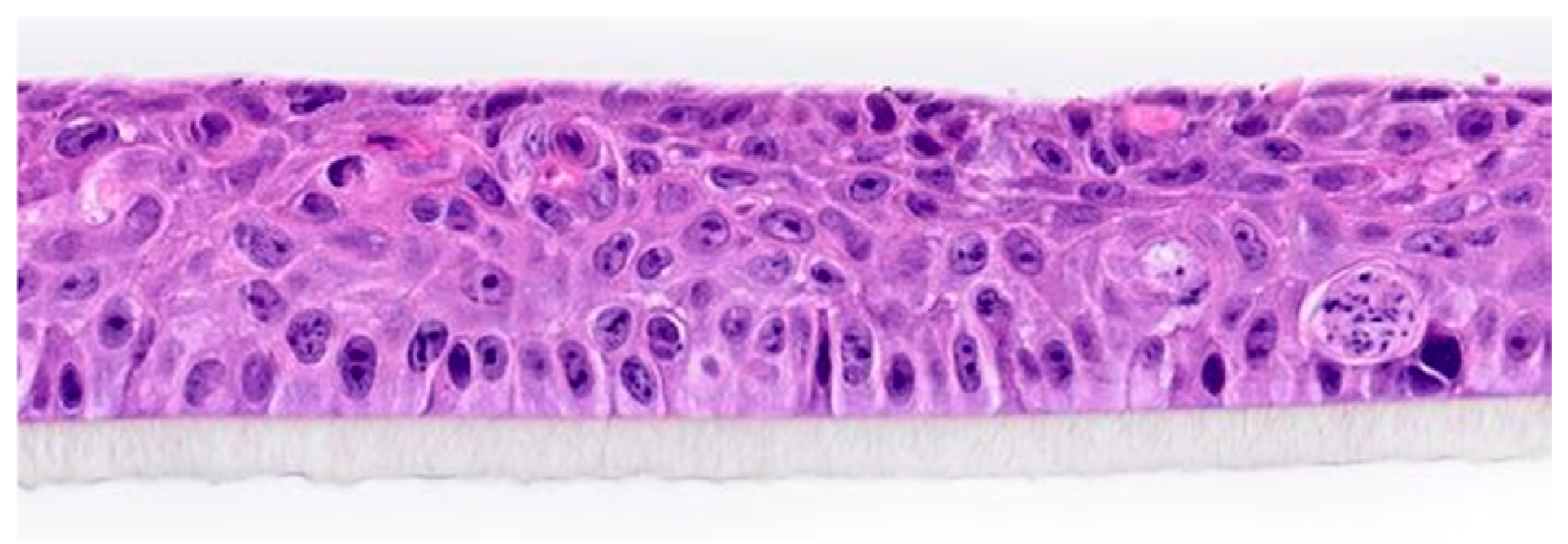
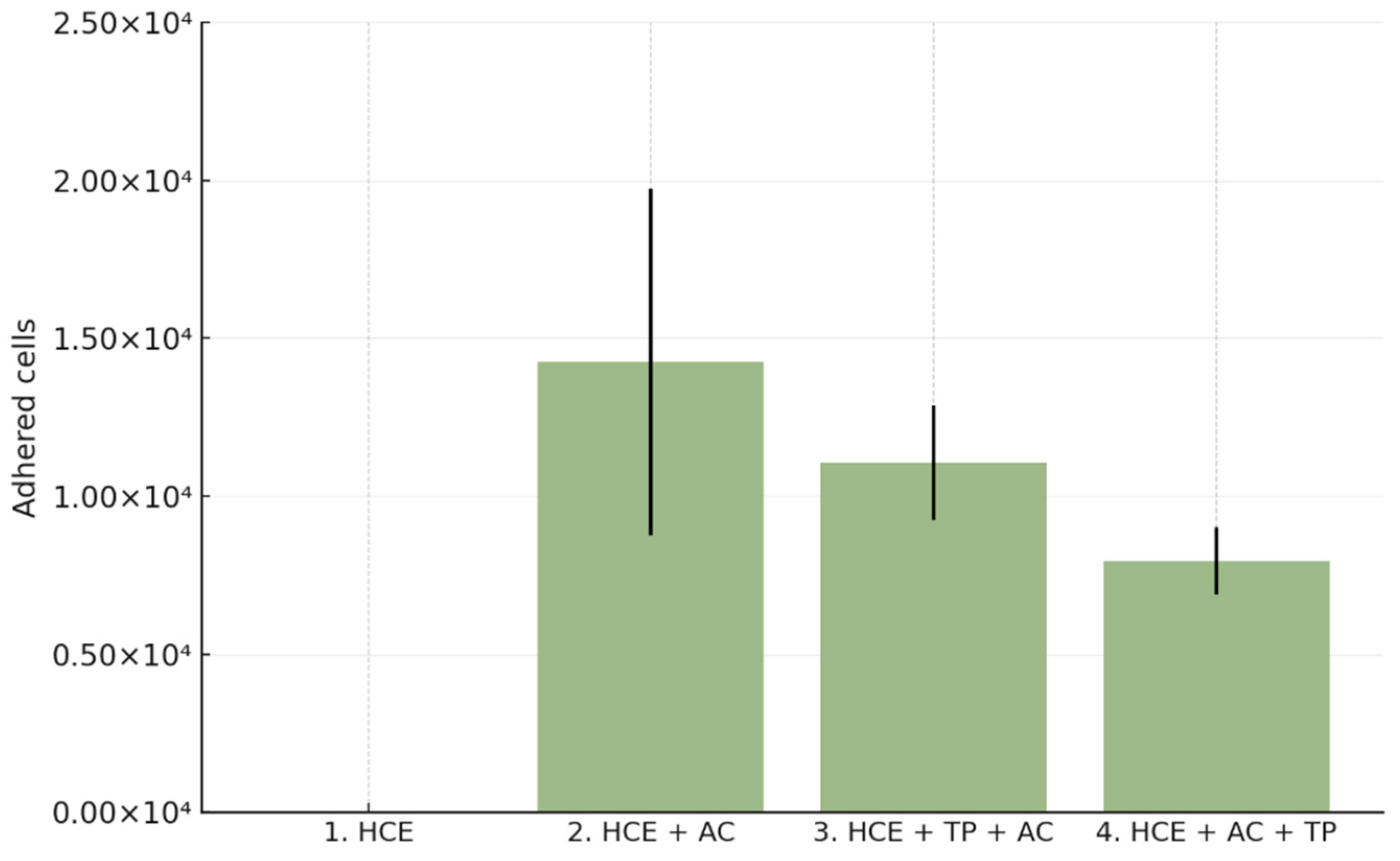
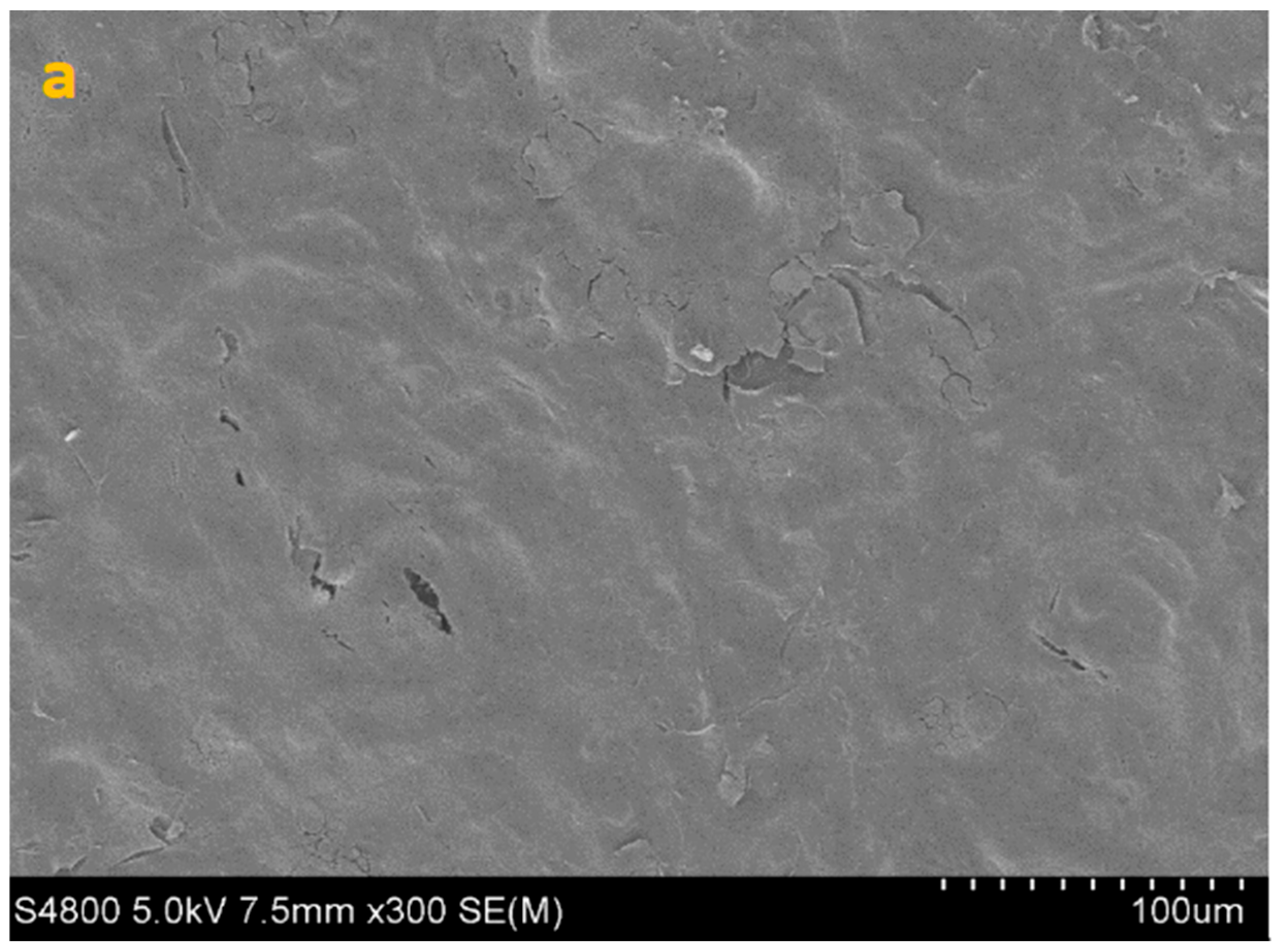
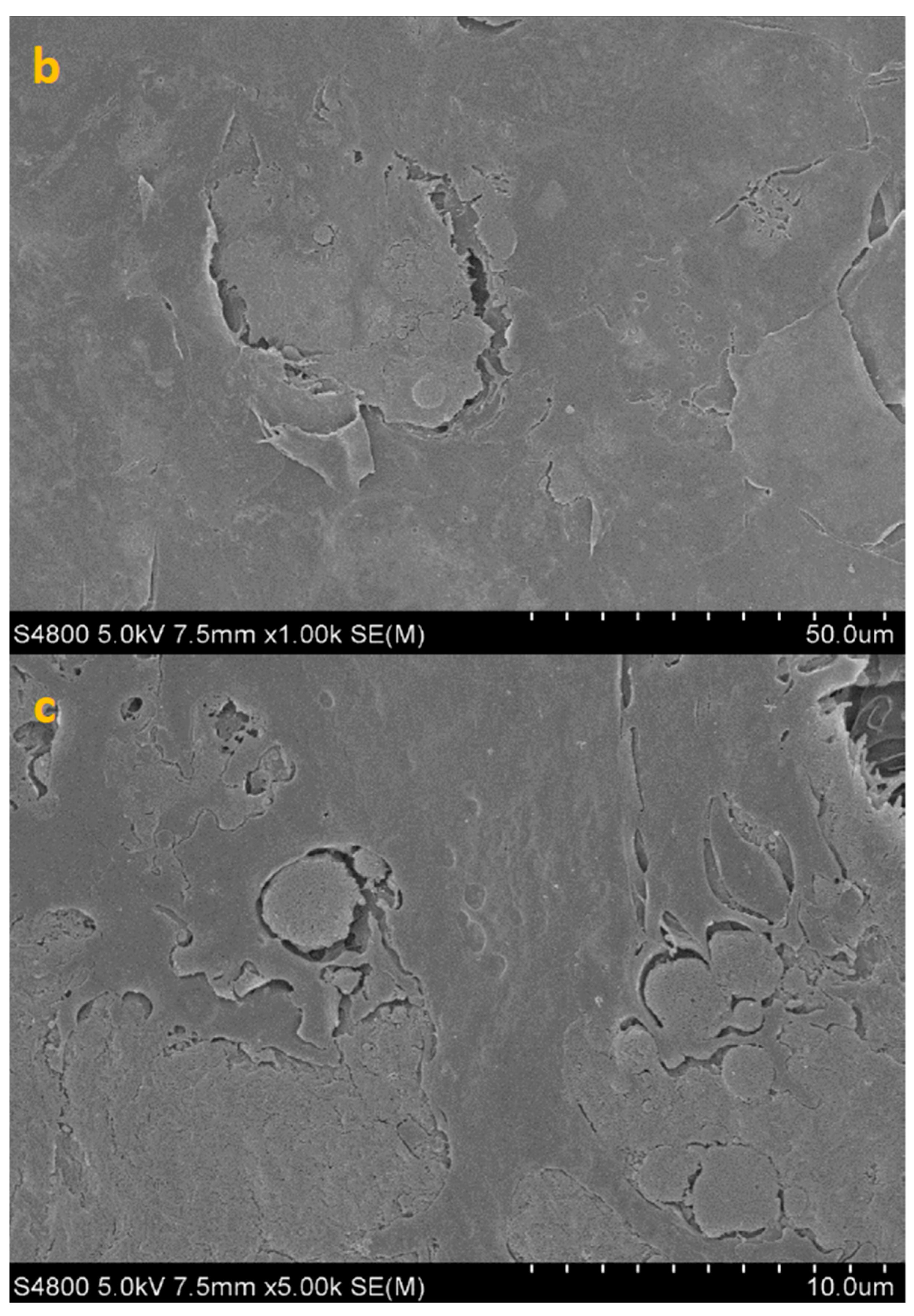
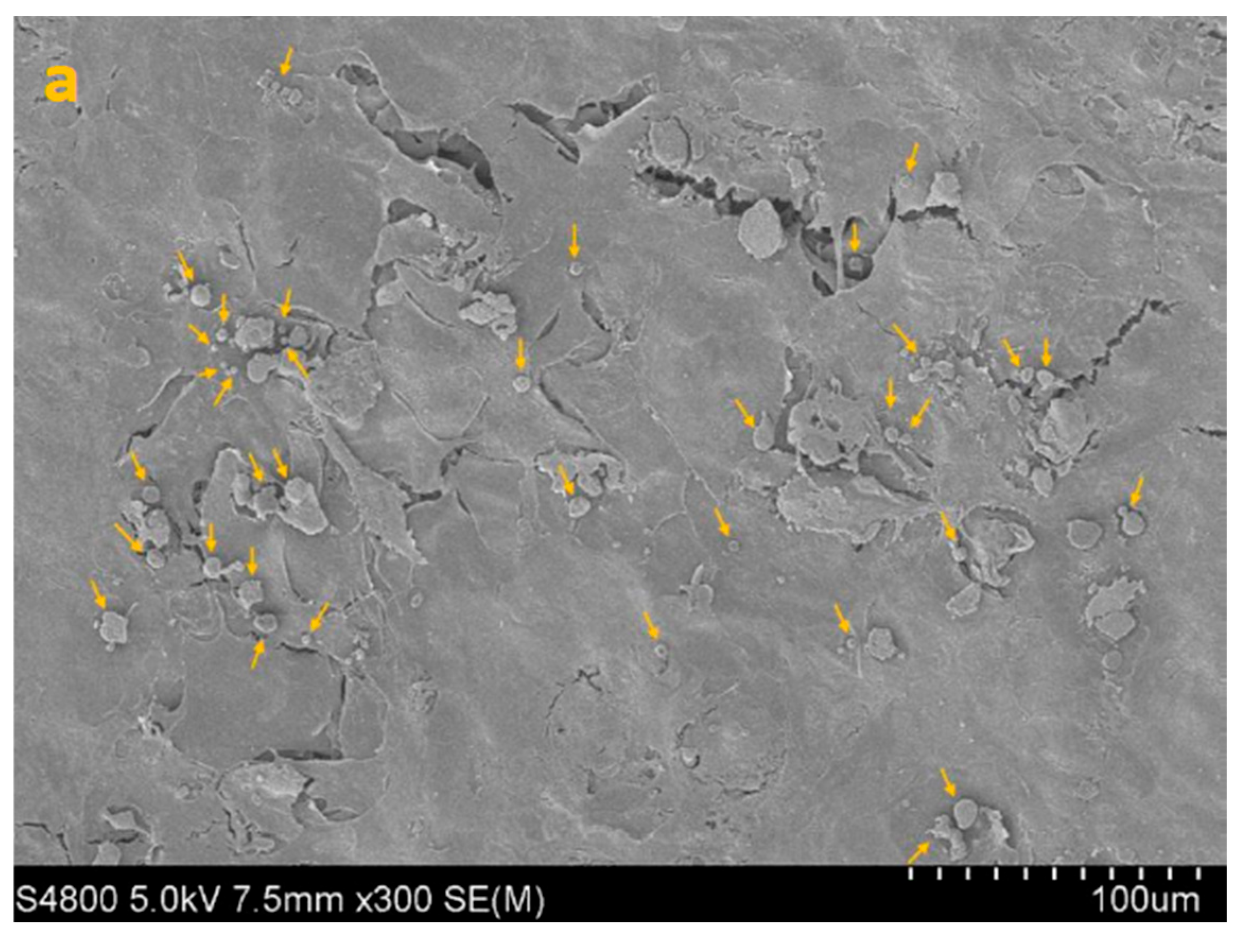
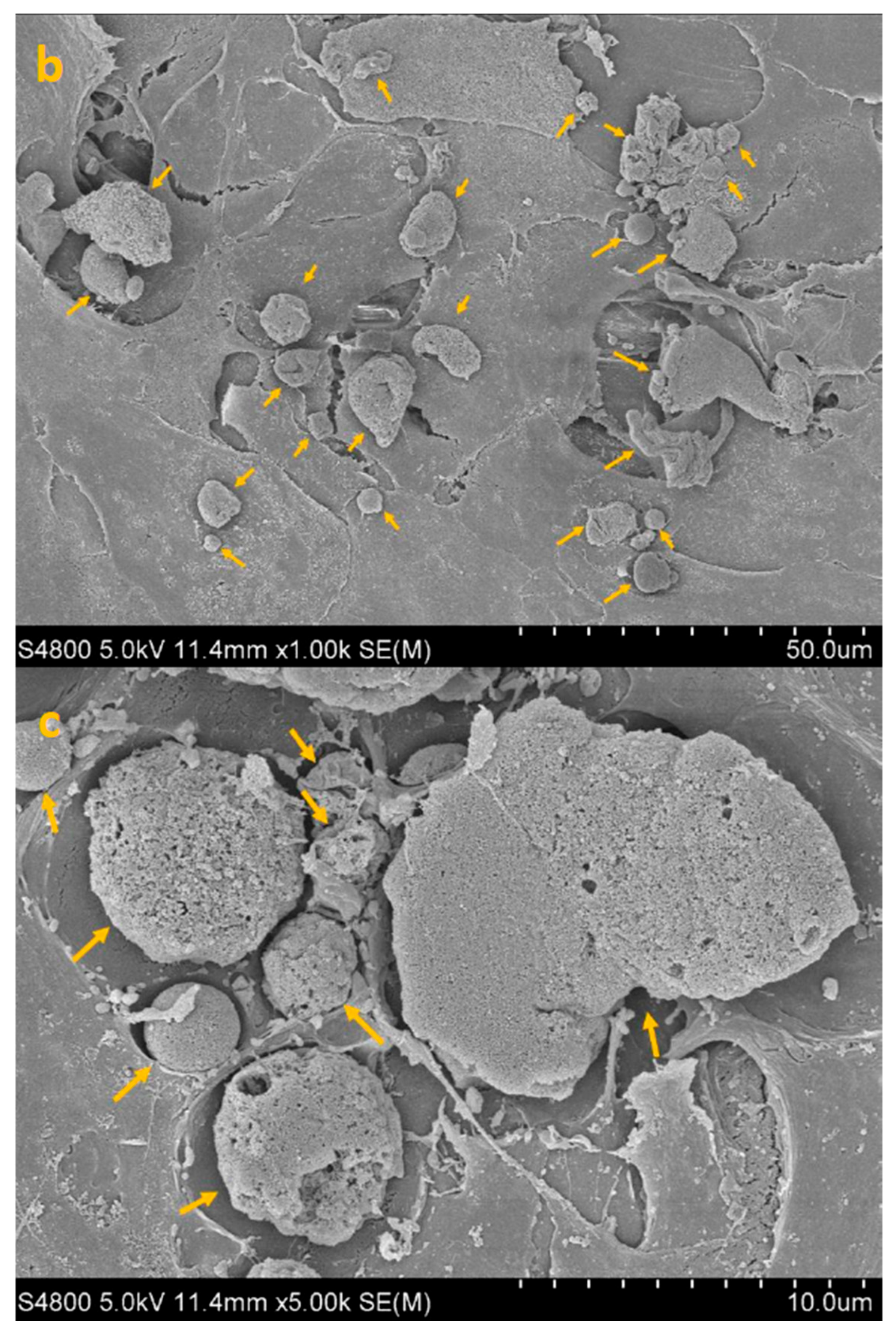
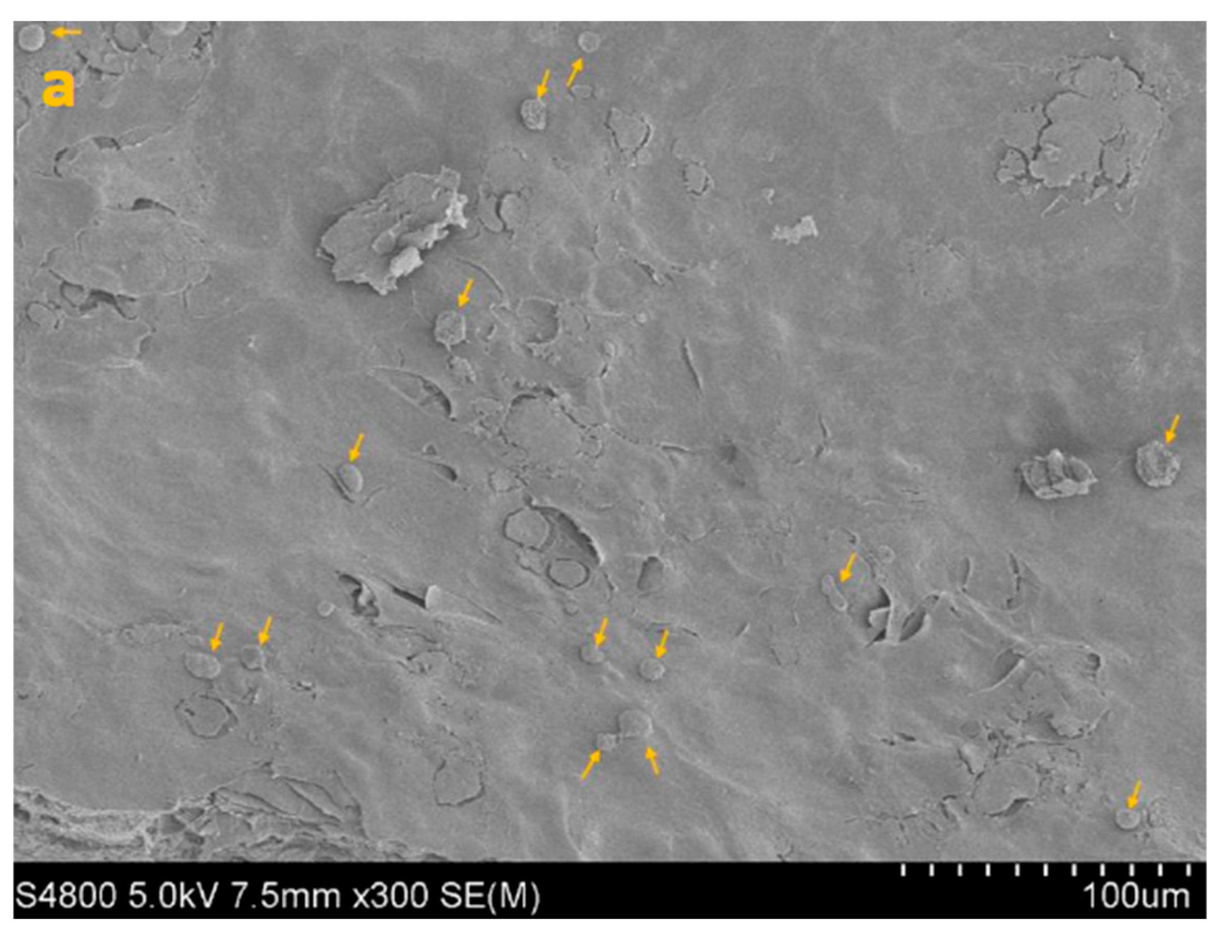

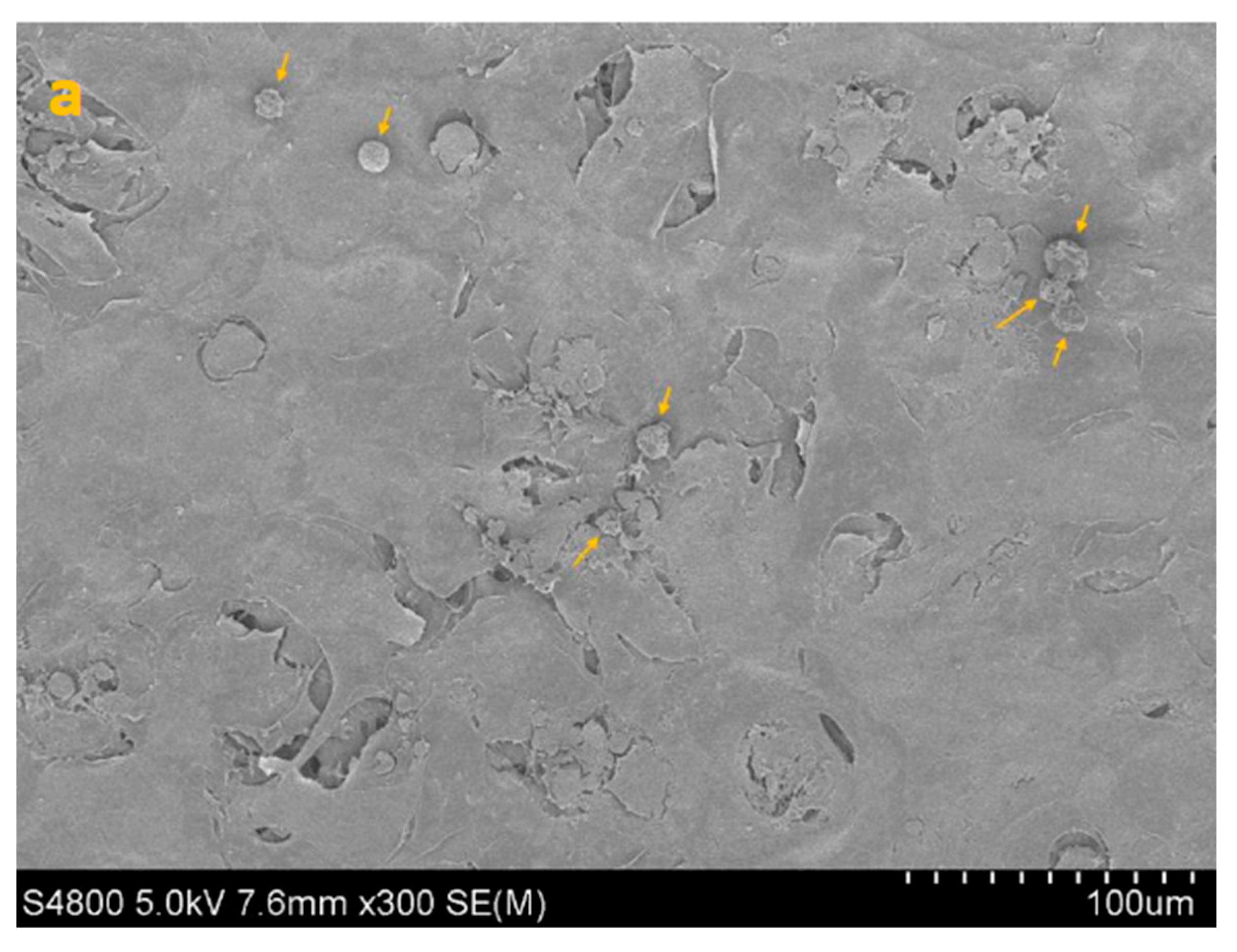
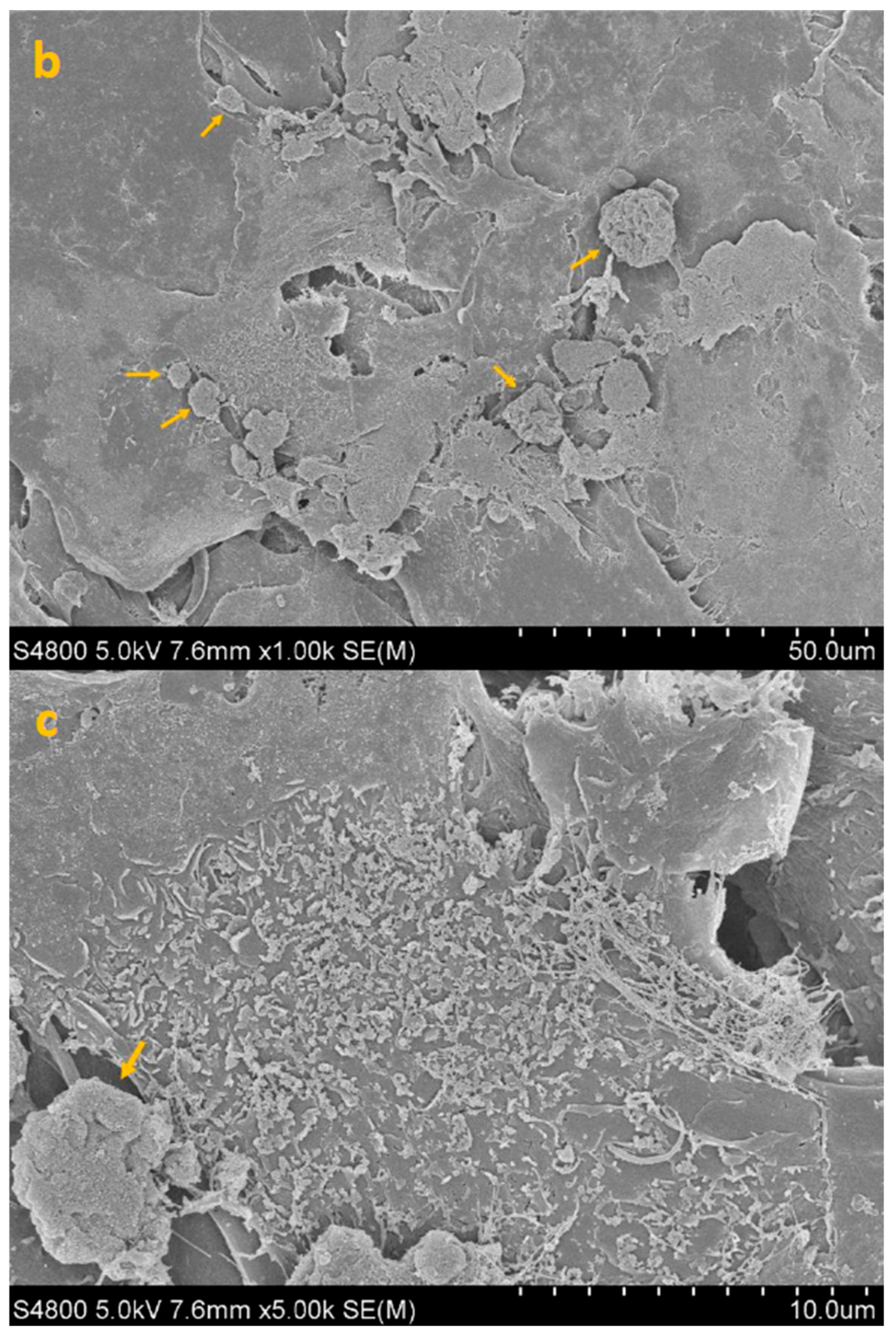
| CORNEIAL MED Eye Drops | HCE + TP + AC | HCE + AC + TP (3 h) | ||
| Mean | SD | Mean | SD | |
| 33.0 | 11 | 51.9 * | 6.5 | |
Disclaimer/Publisher’s Note: The statements, opinions and data contained in all publications are solely those of the individual author(s) and contributor(s) and not of MDPI and/or the editor(s). MDPI and/or the editor(s) disclaim responsibility for any injury to people or property resulting from any ideas, methods, instructions or products referred to in the content. |
© 2025 by the authors. Licensee MDPI, Basel, Switzerland. This article is an open access article distributed under the terms and conditions of the Creative Commons Attribution (CC BY) license (https://creativecommons.org/licenses/by/4.0/).
Share and Cite
D’Oria, F.; Petruzzella, G.; Narvaez, D.; Guerrero, M.; Passidomo, F.; D’Ambrosio, E.; Pignatelli, F.; Addabbo, G.; Alessio, G. Inhibitory Effect of a Novel Ophthalmic Solution on Acanthamoeba castellanii Adhesion and Biofilm Formation on Human Corneal Epithelium. Life 2025, 15, 1685. https://doi.org/10.3390/life15111685
D’Oria F, Petruzzella G, Narvaez D, Guerrero M, Passidomo F, D’Ambrosio E, Pignatelli F, Addabbo G, Alessio G. Inhibitory Effect of a Novel Ophthalmic Solution on Acanthamoeba castellanii Adhesion and Biofilm Formation on Human Corneal Epithelium. Life. 2025; 15(11):1685. https://doi.org/10.3390/life15111685
Chicago/Turabian StyleD’Oria, Francesco, Giovanni Petruzzella, Daniel Narvaez, Marta Guerrero, Fedele Passidomo, Enzo D’Ambrosio, Francesco Pignatelli, Giuseppe Addabbo, and Giovanni Alessio. 2025. "Inhibitory Effect of a Novel Ophthalmic Solution on Acanthamoeba castellanii Adhesion and Biofilm Formation on Human Corneal Epithelium" Life 15, no. 11: 1685. https://doi.org/10.3390/life15111685
APA StyleD’Oria, F., Petruzzella, G., Narvaez, D., Guerrero, M., Passidomo, F., D’Ambrosio, E., Pignatelli, F., Addabbo, G., & Alessio, G. (2025). Inhibitory Effect of a Novel Ophthalmic Solution on Acanthamoeba castellanii Adhesion and Biofilm Formation on Human Corneal Epithelium. Life, 15(11), 1685. https://doi.org/10.3390/life15111685








